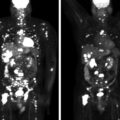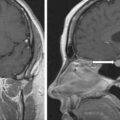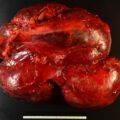Most patients with corticotropin (ACTH)-dependent Cushing syndrome (CS) will have an ACTH-secreting pituitary tumor. When a clear-cut pituitary tumor is found on magnetic resonance imaging (MRI) in a woman with slowly progressive and mild-to-moderate ACTH-dependent CS, proceeding directly to transsphenoidal pituitary surgery (TSS) is a reasonable next step. Herein we present such a case in which inferior petrosal sinus sampling (IPSS) was not needed.
Case Report
The patient was a 26-year-old woman who was referred for a second opinion on whether she might have CS. She developed very subtle signs and symptoms of glucocorticoid excess over the past 2 1/2 years. With plans for fertility, she stopped her oral contraceptive pill 3 years ago and has not had a menstrual period since. She sought consultation with a reproductive endocrinologist, and the serum prolactin concentration was normal, but the serum dehydroepiandrosterone sulfate (DHEA-S) concentration was elevated ( Table 56.1 ). Her symptoms included insomnia (routinely woke between 11:30 pm and 1:30 am and she felt “wired”), new-onset acne, mild hirsutism, and a 10-pound weight gain with distribution above her clavicles, in her face, and on her abdomen. She was diagnosed with new-onset hypertension 1 year ago. She had been working hard to prevent further weight gain with a high-intensity exercise program 5 days a week for 45 minutes. Her only medication was α-methyldopa, 500 mg daily. On physical examination her body mass index was 21.8 kg/m 2 , blood pressure was 138/97 mmHg, and heart rate 96 beats per minute. She did not appear overtly cushingoid. Her skin was normal and there were no purple-red striae. Her abdomen was flat. Compared to her old photographs, she did have supraclavicular fullness ( Fig. 56.1 ). She had good muscle tone and no proximal muscle weakness.
| Biochemical Test | Result | Repeat Test Result | Repeat Test Result | Reference Range |
| Sodium, mEq/L | 142 | 135–145 | ||
Potassium, mEq/L | 4.0 | 3.6–5.2 | ||
Fasting plasma glucose, mg/dL | 85 | 70–100 | ||
Glycosylated hemoglobin, % | 5.2 | 4–6 | ||
Creatinine, mg/dL | 0.7 | 0.6–1.1 | ||
eGFR, mL/min per BSA | >60 | >60 | ||
8 am serum cortisol, mcg/dL | 23 | 15 | 22.9 | 7–25 |
4 pm serum cortisol, mcg/dL | 14 | 2–14 | ||
24-Hour UFC, mcg | 111 | 296 | 103 | 3.5–45 |
24-Hour urine volume, L | 3.7 | 2.4 | 3.1 | Goal <4 L |
Late night salivary cortisol, ng/dL | 190 | 210 | ≤100 | |
ACTH, pg/mL | 80 | 50 | 88 | 10–60 |
DHEA-S, mcg/dL | 687 | 502 | 561 | 44–332 |
Prolactin, ng/mL | 10 | 3–27 | ||
8-mg overnight DST, mcg/dL | 2.1 | Undetectable |
Stay updated, free articles. Join our Telegram channel

Full access? Get Clinical Tree








